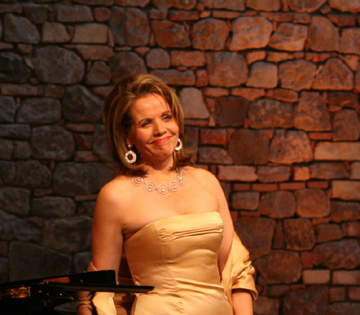
Home run for Festival del Sole
Groined vaults, arched windows, colonnades marching to an ancient vanishing point, and fourteenth century stones drenched with the orange hues of a setting sun. This is not Italy, but the north end of Napa Valley for Festival del Sole. Last Thursday, July 23, at Darius Sattui’s sublime re-creation of an ancient Italian castle, Castello di Amorosa, I had an unforgettable experience. Performing in the open air of its inner courtyard, Renee Fleming showed us what star power is all about.
Believe the hype: this voice is legendary. A combination of prodigious control and profound feeling, either of which would suffice for fame, fueled an evening to be long savored.
Korngold’s Ich soll ihn niemals (I must never see him again) roused us from the castle’s magic with a stronger spell, her sumptuous notes and tight vibrato embroidering the emotion of this elegant kiss-off aria.
After remarks intimating that “…Strauss is my desert island composer,” Fleming next sang Morgen and Zueignung (Dedication), two favorite Richard Strauss songs. Though I was seated towards the rear, her voice was so crystal clear that it easily penetrated in the open air. This was not projection, but its near opposite, an inner luminosity that celebrated the richness of her lower register and kindled pianissimo notes.
From the shifting keys and heavier Romanticism of German she shifted to the ornate runs and brighter vowels of Italian for the “Willow” song from Verdi’s Otello. As the evening’s hues deepened, the castle’s live swallows answered her glittering trills. She sang the part of Desdemona, chanting the Ave Maria with an anguish which gradually transcended to her acceptance of death.
Returning us to our sultry summer evening, Fleming launched into Gershwin’s “Summertime” with highs that shimmered on the soft air and meaty lows that captured an idiom and an age. “Your mama’s good looking,” she sang, with a catch in “look” that the audience appreciated with sighs.
Dave Grusin’s arrangements of “The Water is Wide” and “Shenandoah,” was another high moment. “Wide” was bright and smoky, while “deep” leapt up an octave with naked longing and regret. And brought down the house—and they kept cheering until she encored with “O Mio Babbino Caro.” Effortless.
Double-header at the Castle
Leif Ove Andsnes performed Modest Mussorgsky’s Pictures at an Exhibition on the first half of the program. While most people recognize Ravel’s orchestral version, the piano score was the original, and Andsnes supplied a breadth of color and contrast. This piano version not only demonstrated Andsnes’ virtuosity, but his playful versatility, as he sketched the moods of each “picture.” The exhibition of the title was based on a show organized after the untimely death of Victor Hartmann, an architect and artist and good friend of Mussorgsky, inspiring him to write this tribute.
The various painting motifs are embedded in a primal fabric, the “Promenade,” which Mussorgsky derived from Russian folk song. It holds an elemental 11-beat meter, and he imbues it with every hue from stately walk to stern Bogatyr Gates.
Andsnes, whose lovely performance was overshadowed when Fleming knocked us for a loop, got a chance to shine on the final day of the Festival, Saturday, July 25, performing Beethoven’s Piano Concerto No. 3 with the Philharmonic Orchestra of the Americas. James Gaffigan, assistant conductor of the SF Symphony, was a last minute stand-in for Antonio Pappano. He directed energetically with rounded phrasing that betrayed his insight into Beethoven’s larger design and unexpected wit. Between his lucid explication and Andsnes’ excellent collaboration, the young musicians of the orchestra were inspired to play their best.
—Adam Broner
A version of this article originally appeared in the Piedmont Post.
Photo: Renee Fleming at Castello di Amarosa
